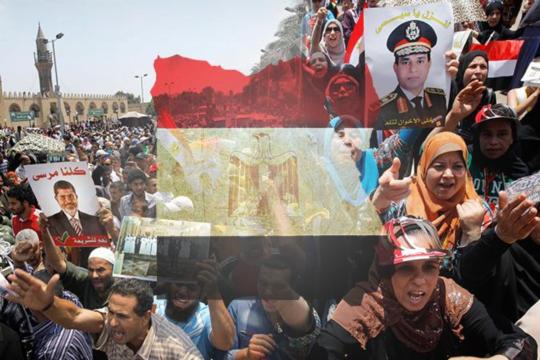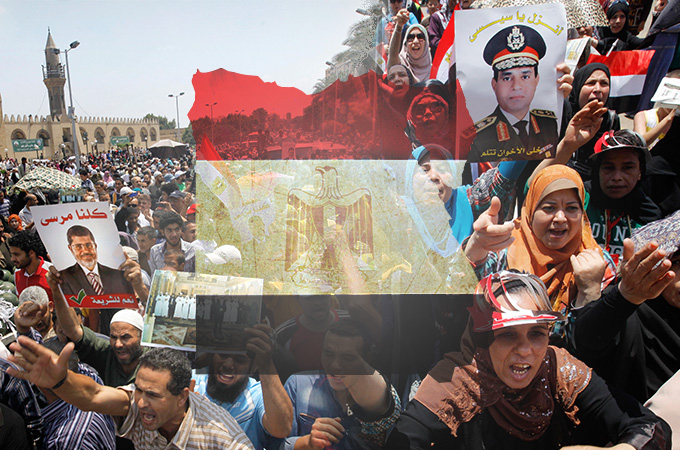
 |
| Source: Al Jazeera |
Egypt is still experiencing anxiety, political uncertainty and insecurity. When the elected president was overthrown, many hoped that the July 3 Regime would be able to achieve stability. It was, however, unable to do so, and failed to sustain its legitimacy in the eyes of the Egyptian public. This paper explains what happened and explores the potential paths for the future of Egypt.
Regional and International Relations
Since the victory of the Tunisian and Egyptian revolutions, three major forces gradually appeared in the Arab-Islamic orient. Firstly, a force that is pro-revolution and pro-change emerged, which garnered sympathy and support from Turkey and Qatar. Secondly, a force emerged that seeks to restore the country to the status quo prior to the revolutions. This force is located in Saudi Arabia, UAE, some other Gulf States and Jordan. Thirdly, a force of a more sectarian nature emerged, seeking to preserve the gains of the geopolitical expansion that it achieved in the first decade of the twenty-first century. These forces are located in Iran, Iraq, Syria and Hezbollah.
These forces have had complex interactions, not strictly through clear geopolitical pathways. Their members are not in agreement on everything, and their interests have intersected in more than one way and on more than one occasion. These intersections could not, however, stop the ongoing conflict between the three forces. There are two main reasons for the emergence of this triple group and their fierce conflict. From the summer of 2012 to this summer, the conflict between the three forces has escalated. The important victory for the first force supporting the revolution and change, however, was achieved in Egypt.
The conflict between the three forces manifested lately in specific locations:
1. Syria: Iran openly and crudely prompted Hezbollah forces to protect the regime from falling, and to help it regain control over the strategic central region. Syria is also the location in which the Arab countries provided armament and financial aid in order to support the Syrian revolution and control the political process after the fall of the Asad regime.
2. Iraq: certain factors weakened the Sunni protest movement, especially after the separation of the Kurdish autonomy authority from the movement. Factors included political pressures and temptations, on the one hand; and the massive amount of money, on the other; and, in addition, some temporary concessions that were made for the Kurds. Although the Turkish protest movement in Taksim Square, which erupted in early June, was initiated by environmental issues, large Shiite and Alawite groups soon joined the protests. The environmental protest movement rapidly turned into a movement to overthrow the Justice and Development Party government.
3. Egypt, where a small and angry group of young people by the name of Tamarod (Rebel), had been active for more than six months. They were employed as a tool to overthrow the Mursi administration and his government by businessmen, politicians, former statesmen and state agencies working against the president.
In most of the previous cases, the U.S. did not necessarily play a direct role, but it is clear that their positions inclined towards diminishing the influence and role of the first force, and not necessarily towards completely excluding it from the scene.
The Structure of the Coup
The Egyptians were divided before the revolution of January 2011, and these divisions returned after their short general agreement during the revolution. There is no doubt that the ousting of President Mursi by the army occurred when this division was at its starkest. The aggravation of political division in the country was an advantageous moment for the state to re-establish its control over Egypt after the revolution of January 2011.
In the revolution of January 2011, Egyptians overthrew an authoritarian regime. The revolution did not affect the prevalent, enormous institution of the Egyptian state though.
The revolution in Egypt was a swift event. It was necessary to immediately begin a comprehensive reform of the state apparatus and subject it to the will of the revolution. The process, however, did not begin; firstly, for the transitional period, the country chose a constitutional framework or quasi-constitutional framework and did not pursue a revolutionary pathway. President Hosni Mubarak stepped down from office, and handed over the reins of power to the Supreme Council of the Armed Forces, which was accepted by the country and its political forces. For many reasons, not least of which is that the Supreme Council is one of the most important institutions of the state, there was no motivation during the transitional period to carry out any sort of reforms. The fleeting moment of unity and agreement between the political forces, and the return of the sharp division that marred the Egyptian political scene before the outbreak of the revolution, also aggravated the situation. Since the mid-nineteenth century, division has been a feature of the political forum of the Arab-Muslim world, but in this particular context, the modern state and the dilemma of its reform and adaptation, holds crucial significance.
This is what made Mursi's presidential victory a blatant coup in the modern state and against the Islamic political force. Due to the severe political division after the victory of the revolution, not enough pressure during the rule of the Supreme Council of the Armed Forces was formed to reform the state and adapt it to the democratic rule that the revolution of January ushered in. Mursi’s presidential victory has seen the political division becoming a great obstacle in the way of reform. The inclination toward the old state apparatus by the traditional Egyptian political forces —liberal and semi-liberal, nationalist and patriotic— imposed additional restrictions. The reform steps were thus slow and disrupted, and the steps toward reform turned into a deep political crisis in the country.
This enormous entity, which we abstractly call the state, has its own essence and retains its own speech, traditions and legacies, to establish a very complex network of interests. It is not easy for a political movement that is unfamiliar with the institution of the state —a movement that was considered for many decades to be a marginal or hostile enemy— to move to the centre, and thus hold the reins of the state. Indeed, the transition was only theoretical, and did not become a reality at the end of the first year of Mursi’s presidency.
After the Coup
Despite early expectations that the conditions of the country would stabilise and that the political forces opposing the overthrow of the president and the July 3 roadmap would accept the fait accompli and join the new political process, the popular protest movement continued unabated. The regime faced the crowds gathered at Raba'a al-Adaweya, and when violence failed to suppress the opposition movement, security apparatus resorted to a campaign of mass arrests. The clearing of the two sit-ins was carried out with extreme force, unprecedented in the modern history of Egypt, and it continued throughout Wednesday August 14, ending with the killing of thousands of protesters and injuring thousands more. The consequences of clearing the two sit-ins in Cairo, which saw the protest and the opposition movement returning stronger and with more tenacity, reaching all parts of the country and using new tactics of mobility in the streets, were different to those expected by the leaders of the regime.
Where is Egypt Heading?
There are four main possibilities of where the situation in Egypt can lead to:
1. The July 3 regime can establish itself and restore stability by force of arms and different methods of repression, regardless of whether it succeeds in convincing the majority of Egyptians of its legitimacy.
2. Reversing the coup and the procedures taken by the July 3 regime since the overthrow of Mursi. This cannot be achieved without the decision of the General Command of the Armed Forces, the dominant force in the new regime. It also requires the popular movement to significantly escalate and expand, increasing aggravation of the financial crisis, and significant foreign pressure.
3. Reaching a negotiated agreement between the new regimes, especially the leadership of the armed forces on the one hand and the National Alliance for Supporting Legitimacy, which leads the popular protest movement, on the other.
4. The country can fall into deeper levels of political instability, coupled with increasing levels of armed violence. In the event that attempts to reach a negotiated agreement fail, and that the new regime inclines towards eliminating the Muslim Brotherhood and the political forces supporting them, whether in a constitutional and legal manner or otherwise, Egypt will move towards a seemingly endless phase of political instability in a climate of political repression and terrorism.
Click here to read the full article.
Copyright © 2013 Al Jazeera Center for Studies, All rights reserved.